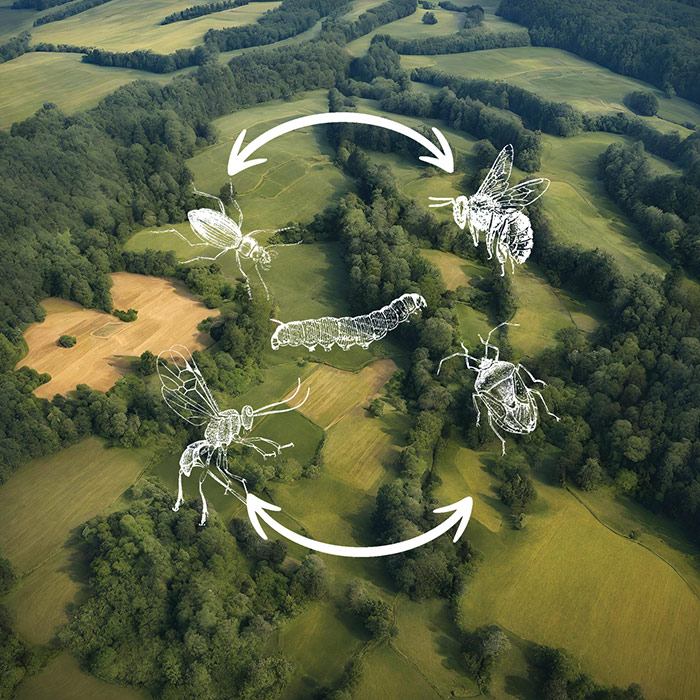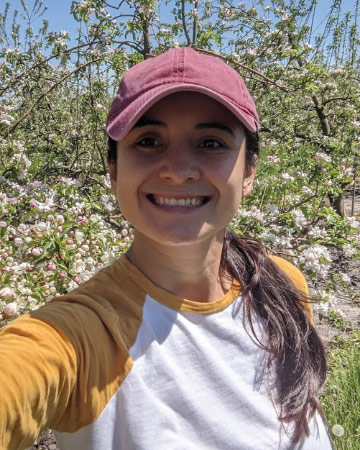Why Does Landscape Matter for IPM?
 |
|
Herbivores, pollinators, and natural enemies move across land covers, changing local dynamics. Image provided by Diana Obregon |
By Diana Obregon, Postdoctoral Associate, New York State Integrated Pest Management Program
Crops don’t grow in isolation; they are embedded in a matrix of different land covers that influence what is happening in the fields.
Landscape composition and configuration can tremendously affect the abundance and diversity of herbivores, pollinators, and natural enemies due to the movement of organisms and their functions among natural and agricultural areas. If the landscape effect is not considered, it becomes harder to predict the success of integrated pest management (IPM) strategies.
The constant changes in land use and the expansion of areas for agriculture and livestock production make this topic relevant. This is why it is crucial to understand how landscapes impact ecosystem services and their cascade effects on productivity. Following are some examples.
Natural Areas and Pest Parasitism
Crops don’t grow in isolation. They are embedded in a matrix of different land covers that influence what is happening in the fields.
In strawberry fields in New York State, it was shown that the decrease of natural areas surrounding the crops results in a reduction of parasitism rates of crop pests, with higher numbers of the pests, and a consequent reduction in yield (Grab et al. 2018).
Similar results were found for Lepidopteran herbivores in cabbage crops, where landscapes with a lower proportion of meadows showed an increased infestation, likely resulting from decreased parasitism (Perez-Alvarez, Nault, and Poveda 2018).
Agricultural Effects on Predation
Landscape effects can be complex and sometimes unpredictable. A study looking at the predator community of ground beetles in different cabbage fields found that in agriculturally dominated landscapes, beetles shifted their size distribution toward larger body sizes with higher predation rates (Perez-Alvarez et al. 2021).
Landscape Complexity and Pollinators
As for pollinators, they tend to decrease their abundance and diversity as the landscape is more simplified, which can commonly result in negative consequences for yield (Connelly, Poveda, and Loeb 2015; Obregon et al. 2021). This trend can be explained by the loss of floral and nesting resources that the pollinators need to thrive (Heard et al. 2007; Potts et al. 2005).
Beneficial Organisms’ Pesticide Exposure
Landscapes can also modulate pesticide exposure for beneficial arthropods. In apple orchards, it was shown that the predation rate of sentinel eggs of the codling moth (Cydia pomonella) was negatively affected by the toxicity of the crop protection program in the farm, but also by the amount of agricultural area surrounding and the pesticide regime in adjacent farms (Monteiro et al. 2013).
Also, in apple orchards, it was shown that the use of pesticides is negatively correlated with bee richness. However, this effect was weakened on farms with more natural habitats in the landscape (Park et al. 2015).
Landscape and Management Factors Viewed Holistically
Scientific evidence suggests that landscapes with dense and connected natural vegetation may enhance populations of beneficial arthropods.
In general, scientific evidence suggests that landscapes with dense and connected natural vegetation may enhance populations of beneficial arthropods, which immigrate into the crop fields to regulate pest populations and pollinate.
However, it is always good to keep in mind that the immense diversity of organisms and cultivated plants can result in unexpected interactions, with particular patterns emerging when considering not only the local conditions but also the landscape level.
IPM recommendations should be tested at different landscapes, which will inform their effectiveness and the areas where adoption should be prioritized. Understanding the landscape context is also crucial for collaborative pest-management efforts since coordinating pest-control strategies across properties can be more effective in preventing pest outbreaks and reducing overall pest pressure.
 |
|
Diana Obregon. |
About the Author
Diana Obregon is a postdoctoral associate working on pesticide risk assessment at the New York State IPM Program, based at Cornell University. Diana received the Outstanding Achievements in Integrated Pest Management Award from the Northeastern IPM Center in 2022 for her contributions to pollinator protection in agricultural systems.
Literature Cited
Connelly, Heather, Katja Poveda, and Gregory Loeb. 2015. “Landscape simplification decreases wild bee pollination services to strawberry.” Agriculture, Ecosystems & Environment 211 (December): 51–56.
Grab, Heather, Bryan Danforth, Katja Poveda, and Greg Loeb. 2018. “Landscape simplification reduces classical biological control and crop yield.” Ecological Applications: A Publication of the Ecological Society of America 28 (2): 348–55.
Heard, M. S., C. Carvell, N. L. Carreck, P. Rothery, J. L. Osborne, and A. F. G. Bourke. 2007. “Landscape context not patch size determines bumble-bee density on flower mixtures sown for agri-environment schemes.” Biology Letters 3 (6): 638–41.
Monteiro, Lino B., Claire Lavigne, Benoît Ricci, Pierre Franck, Jean-François Toubon, and Benoît Sauphanor. 2013. “Predation of codling moth eggs is affected by pest management practices at orchard and landscape levels.” Agriculture, Ecosystems & Environment 166 (February): 86–93.
Obregon, Diana, Olger R. Guerrero, Elena Stashenko, and Katja Poveda. 2021. “Natural habitat partially mitigates negative pesticide effects on tropical pollinator communities.” Global Ecology and Conservation 28 (August): e01668.
Park, Mia G., E. J. Blitzer, Jason Gibbs, John E. Losey, and Bryan N. Danforth. 2015. “Negative effects of pesticides on wild bee communities can be buffered by landscape context.” Proceedings. Biological Sciences / The Royal Society 282 (1809): 20150299.
Perez-Alvarez, Ricardo, Heather Grab, Anthony Polyakov, and Katja Poveda. 2021. “Landscape composition mediates the relationship between predator body size and pest control.” Ecological Applications: A Publication of the Ecological Society of America 31 (6): e02365.
Perez-Alvarez, Ricardo, Brian A. Nault, and Katja Poveda. 2018. “Contrasting effects of landscape composition on crop yield mediated by specialist herbivores.” Ecological Applications: A Publication of the Ecological Society of America 28 (3): 842–53.
Potts, Simon G., Betsy Vulliamy, Stuart Roberts, Chris O’Toole, Amots Dafni, Gidi Ne’eman, and Pat Willmer. 2005. “Role of nesting resources in organising diverse bee communities in a Mediterranean landscape.” Ecological Entomology 30 (1): 78–85.
The Northeastern IPM Center promotes integrated pest management for reducing risks to human health and the environment. If republishing our news, please acknowledge the source (“From Northeast IPM Insights”) along with a link to our website.
